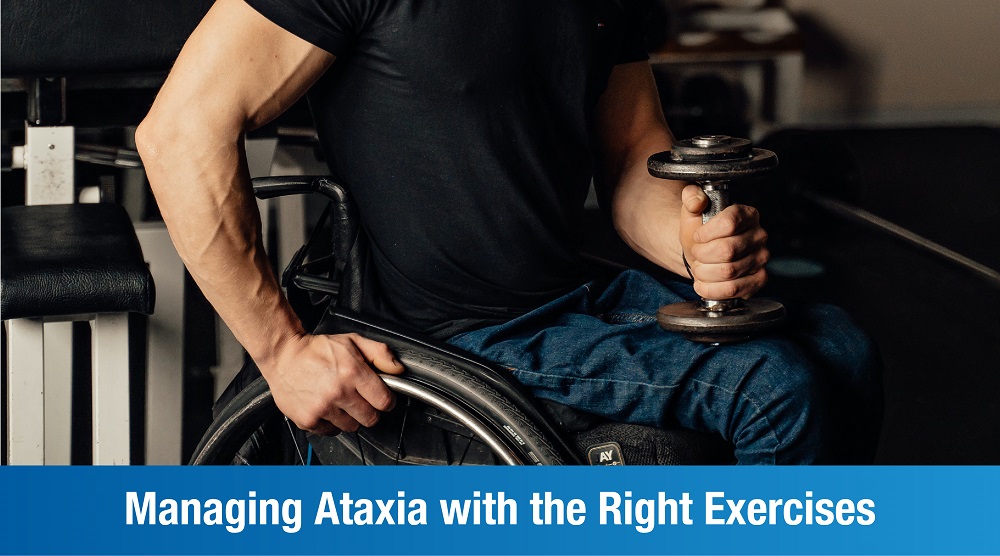
Spinocerebellar Ataxia is a rare disease that affects voluntary muscle movement. There is currently no cure, but treatment can slow the progression and give patients a productive, fulfilling life. In particular, exercise has several benefits in enhancing muscle control and thus combating Ataxia over time. Let’s take a look at how exercise can help, as well as some of the exercises that your physiotherapist might recommend.
Understanding Spinocerebellar Ataxia
Spinocerebellar Ataxia, Spinocerebellar atrophy, or Spinocerebellar degeneration is a genetic disease caused by either a recessive or dominant gene. It refers to a group of Ataxias that are known to be hereditary and cause harm to the cerebellum – the part of the brain which maintains balance and controls movement. Spinocerebellar Ataxia may result in non-coordinated gait, impaired hand-eye coordination, and abnormal speech. Because this condition affects the nervous system, it is also known as a nervous disorder.
Exercise for Spinocerebellar Ataxia
The main symptom of Spinocerebellar Ataxia is a lack of control over muscle movement. It occurs due to damage in the part of the brain that controls voluntary movement, and hinders daily activities like picking up things, feeding oneself, or walking around. While some of these activities can be completed with adaptive or assistive devices, exercise is the best way to bring about long-term recovery of muscle function.
Physical exercise is a crucial component of any Spinocerebellar Ataxia treatment program. Exercise can help to improve gait, enhance muscle function, and reduce the risk of falls. Some exercises may focus on restoring muscle abilities in the patient’s limbs, while others focus on compensating for the deficiency in the limb in conjunction with assistive devices. Regardless, the end goal of exercise is to equip the patient with as much mobility as possible. Here are some of the exercises that your physiotherapist may recommend.
- Sit to stand: This exercise builds lower body strength and improves mobility. To perform this, sit on a chair with your knees hip-width apart and feet under your knees. Gradually shift your upper body weight forward, transferring it to your legs, and use your leg muscles to stand up. Sit down again slowly and repeat this at least 10 times.
- Quadruped opposite arm and leg extension: This exercise builds core stability and helps with reaching for objects. Start by kneeling while putting your hands under your shoulders and your knees under your hips. Raise one arm slowly till shoulder height, then raise the opposite leg to hip height, and balance for a second. Gradually pull your arm and leg back and repeat on the other side for at least 10 rounds.
- Sitting lateral weight shifts: This exercise builds core stability while you remain in a seated position. Sit upright on an exercise ball with your knees hip-width apart and your feet under your knees. Slowly move your upper body from side to side, allowing your trunk to shift and bear the weight. Repeat 10 times. To make it easier, sit on a steady surface and place your hands on either side.
- Standing anterior-posterior weight shift: This exercise serves as a precursor to walking by improving balance. Stand with your feet hip-width or wider apart. Gradually, shift your body weight back and forth between your toes and your heels. Perform 10 repetitions, holding on to something for support if necessary.
- Single leg stance: This exercise improves balance and makes walking easier. Stand upright and slowly shift your weight onto one leg while lifting the other leg off the ground. Slowly lower the leg and do the same on the other side. Perform 10 repetitions. Try to balance on each leg for as long as possible.
For maximum benefit, home exercises should be performed at least three times a week, in sessions that are at least 20 to 30 minutes long. Whenever performing an exercise for the first time, keep it to two or three sets of eight to ten repetitions, in a controlled manner. Once you become more confident, you can increase it to 12 to 15 repetitions. When using weights, always start with light ones and be sure to maintain the correct form. In addition, aerobic exercises such as running, biking, or swimming improve overall cardiovascular health and help to maintain a healthy weight.
In conclusion, exercise has a myriad of benefits as part of Spinocerebellar Ataxia treatment, in terms of improving coordination, balance, strength, and mobility. Be sure to perform all exercises with care and to stop at once if you feel any pain or discomfort. Over time, you will see functional improvements that allow you to lead your life more independently.










